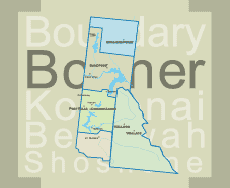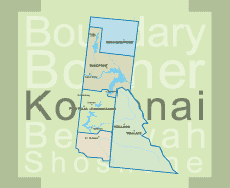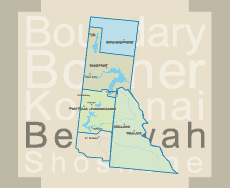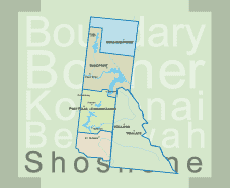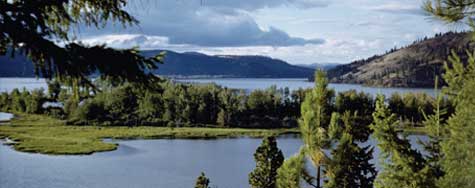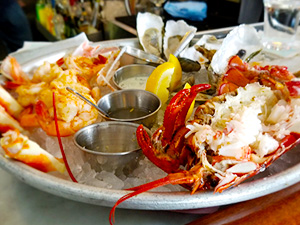Local Facts
Population: 12,765
Elevation at Lookout Pass: 2,900 - 6,100
Access to 72 mile biking trails: Trail of the Coeur d’Alenes
Cataldo Mission, oldest standing building in Idaho.
Nestled between the Coeur d'Alene Mountains and the Bitterroot Range, the Silver Valleys past overflows with history. While many people were attracted to this area for the shear beauty of the surroundings, early entrepreneurs were attracted to the glitter of gold hoping to line their pockets with currency. The promised “gold” turned out to be overshadowed by its just as enticing cousin, Silver. The town of Wallace popped up in 1884 to accommodate the influx of men (and a few women) seeking their fortunes in the luster of precious metals. The Silver Valley, producing 1.286 billion ounces of silver between 1884 and 2006, is still going strong. Despite its mountain riches, this area is just as well known for its reputation as an outdoor enthusiast’s dream. The Silver Valley region is over 80% forest-owned land managed by State and federal entities, has hidden seasonal trails and historic paved wonders to bring you up close and personal with a natural treasure.
The Coeur d’Alenes Old Mission, (Exit 39) located at Old Mission State Park was constructed in 1854 by Jesuit priests. The structure has foot-thick walls that were built without the use of nails and designed in the tradition of grandeur native Italian cathedrals.
Kellogg was named after miner, Noah Kellogg, who established the Bunker Hill Mine in 1892 after following a wayward mule. During this time, Kellogg was linked by rail to the Coeur d’Alene River at Cataldo where steamboats brought supplies from Coeur d’Alene. Mining was king in Kellogg until the mid 1980’s when the economy transitioned to tourism and fun on the slopes.
Be sure to plan a visit to Silver Mountain and treat yourself to an elevating adventure by planning a ride to the top in North America’s longest single-stage gondola. During the summer months, tee off at Silver Mountain’s brand new 9 hole golf course, Galena Ridge, offering golfers of all abilities stunning mountain views, with some very dramatic elevation changes. Enjoy patio dining, hiking, adventurous mountain biking and other activities. Surf’s up! Learn to surf in the indoor water park, roughly the size of two football fields. It includes a lazy river, kids play area, slides, flow rider surf wave and swirling pools. When snow falls, bring your snowboards and skis and experience powder only the Northwest can offer! Silver Mountain Resort offers exceptional snow quality, seven lifts, 2,200 vertical feet and 2,500 incredible acres of fun. Kellogg lays snuggled at the base of Silver Mountain where history buffs flock to Kellogg’s Staff House Museum, shoppers peruse the alpine shops, or meander along the Dave Dose Trail of whimsical sculptures. Just west of Kellogg, the historic Wardner Museum welcomes you to the founding site of the Bunker Hill Mine. Fascinated by the underground? Visitors are invited to explore the Crystal Gold Mine, an authentic 1880’s gold mine and see unusual crystal formations, native silver, gold-bearing quartz, and mining artifacts. Two miles further east at Big Creek, (Exit 54) is the Sunshine Mine Memorial, dedicated to 91 miners who died in a mine disaster in 1972.
Wallace, “Silver Capital of The World”, (Exit 61), is one of a few towns in its entirety listed on the National Register of Historic Places and is always worth a visit. Highlights include the Wallace District Mining Museum, the Northern Pacific Depot Railroad Museum, and Oasis Bordello Museum. Celebrate Wallace heritage at one of it’s annual festivals. Gyro Days/Lead Creek Derby in June or the Huckleberry Picking Festival in August. For another unique adventure, hop aboard the Sierra Silver Mine Tour trolley, where you will take a short ride out to the mine. At the mine you will be met by a retired miner, and travel underground to learn how an actual silver mine operates. Along your visit to downtown Wallace, visit the fine silver and gift shops and admire period architecture from Wallace’s heyday. There is a walking tour of Historic Wallace. The homes in the in the Historic District are local renditions of the American Colonial revival and bungalow styles, some with Queen Anne elements and some of the English Cottage style prevalent in the 1930’s. The tour covers residential and commercial districts of the city.
Cap off your evening with dinner at one of the Silver Valley’s unique restaurants. For an after dinner treat, grab tickets for a show at the 6th Street Melodrama Theater and enjoy an evening of colorful 1880’s-style entertainment. Further east, at Mullan (Exit 68 & 69) you will find another historical mining community nestled among the peaks. Take in some of the local history and color at the Captain John Mullan Historical Museum. Mullan is the ideal stopover when you’re traveling between Lookout Pass and Wallace. It is also access to the Trail of the Coeur d’Alenes biking trailhead. Gleeful bikers traverse the 73-mile Trail, a paved path that runs from Mullan to Plummer, passing over a historic bridge on Lake Coeur d’Alene. Spanning the border of Idaho & Montana, this rails-to-trails route runs into the Nor Pac Trail onto the noteworthy Hiawatha Trailhead, an unforgettable family mountain biking experience. The Route of the Hiawatha is a bike trail created from the old Milwaukee Road rail bed. The name is taken from the Olympian Hiawatha, a passenger train that offered transcontinental service from Chicago to Puget Sound. The railroad here was built between 1906 and 1911. And after 70 years of hardship and glory was abandoned in 1980. In May 1998 a portion of the route was reopened to recreational use in the form of a 15-mile groomed biking path that follows what was once the great Milwaukee Railroad. The trail takes you through 11 large train tunnels and across 9 sky-high trestles to the North Fork of the St. Joe River. Have your flashlights and bike lamps ready when you enter the 1.7 miles of darkness of The Taft Tunnel.
Mullan also boasts a branch of the Idaho State Fish Hatchery, the Lucky Friday Mine, Shoshone Park, and access to miles of hiking, mountain biking, and snowmobiling trails, including hiking trails to Lone Lake and Stevens Lake. More than a dozen alpine lakes can be found within a few miles of Wallace, Mullan or Murray . While a couple of them are accessible by ATV or jeep, most are not. The steep 3-mile Lower Lake Stevens trail rises about 1700 feet through a mature conifer forest past cascading waterfalls. Many trails such as this one exist around the Valley, as well as easier trails for the novice hiker.
Head 4 miles east of Mullan until you reach Lookout Pass, a recreation site straddling the Idaho-Montana border. Year round, the Lookout Pass area is another prime departure site for snowmobiling, fishing, hiking, horseback riding, and mountain biking in the Bitterroot Mountains of the Idaho Panhandle National Forest.
Returning to Wallace, take 6th Street north (which becomes Nine Mile Road, FS Road 456 North) over Dobson Pass, for a 17-mile tour to Prichard. Take a right-hand turn on FS Road 9. After two miles take another right on FS Road 153 east to Murray (6 miles). Keep a lookout for wildlife. You might spot a deer or two, or even a prickly little porcupine. The Silver Valley offers bow, rifle and muzzleloader hunting for deer and elk. Black bears, mountain lions and wild turkey are also hunted. Fishing is another favorite. At Murray, you can take a step back into gold mining history. Only about 100 people live there now but in it’s heyday, Murray was the central city of the last great gold mining stampede in the Lower 48 (1883-1885). This area continues to produce silver, gold, lead, and zinc. Be sure to visit the Sprag Pole Inn Museum. Just one mile south of Murray, stop at a historic cemetery to honor the last resting place of early pioneers and colorful characters such as Molly B’ Damm and Captain Toncray (credited to be Mark Twain’s inspiration for his Huck Finn character).
Return west on FS Road152, and travel 3 miles to [8] Eagle, the Coeur d’Alenes’ first gold rush camp. Wyatt Earp, one of the early day western lawmen, whose reputation has been much written about, played a role in the early days of the Shoshone County mining district. He lived here with his two brothers, James C. and Warren Baxter Earp in 1884. Records show that Wyatt’s stay in Eagle was a busy one where he served as a deputy sheriff, a saloon keeper and was even accused of claim jumping.
Turning right at the junction, follow FS Road 152 to its junction with Road 805. Follow this road for six miles to Settler’s Grove of Ancient Cedars, an old-growth forest of trees. This grove, which narrowly escaped the cataclysmic 1910 fire, has trees that are hundreds of years old with trunks up to 8 feet in diameter.
Return to FS Road 152 west to FS Road 9 for a leisurely drive south along the wild scenic North Fork of the Coeur d’Alene River or you could continue on to Highway 200 to visit Glacier National Park.
Snake Pit



More about Glacier National Park...
Print
Email
Sandpoint Idaho lies on the shores of Idaho's largest lake, 43-mile-long Lake Pend Oreille, and is surrounded by three major mountain ranges, the Selkirk, Cabinet and Bitterroot ranges. It is home to Schweitzer Mountain Resort, Idaho's largest ski resort. The opening of Schweitzer Mountain Resort in 1963 turned the area into a year-round tourism destination. The beauty of the surrounding Selkirk and Cabinet Mountains and Lake Pend Oreille has kept Sandpoint a tourist favorite for water sports, hunting, hiking, horseback riding, fishing and skiing and is on the International Selkirk Loop and two National Scenic Byways (Wild Horse Trail and Pend Oreille Scenic Byway).
Sandpoint was named the nation's "Most Beautiful Small Town" by Rand McNally and USA Today.
Sandpoint offers an array of fine shopping including the picturesque Cedar Street Bridge Public Market, spanning 400 feet across Sand Creek in downtown Sandpoint, the Cedar Street Bridge Public Market is heralded as the only marketplace on a bridge in the United States.
Sandpoint is alive and vibrant with year-round theatre performances, art events, fairs, movies, plays and festivals including the Festival at Sandpoint held the first 2 weeks in August. Visit the restored historic Panida Theater at 300 N. First Street. Summer activities include golfing, fishing, cruises, sea kayaking , swimming, mountain biking, hiking, boating or for something different visit the local winery.
Ice Cream Shops
Coeur d'Alene, Sandpoint named top mountain towns
North Idaho Resorts and Hotels
North Idaho Relocation Resources
The Arts
Huckleberries
Festival at Sandpoint
Print
Email

